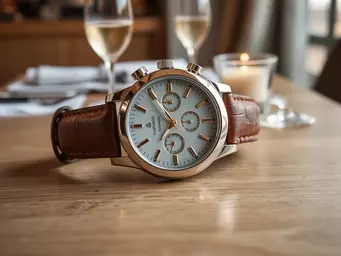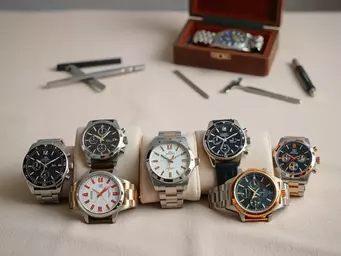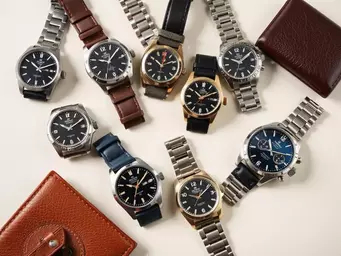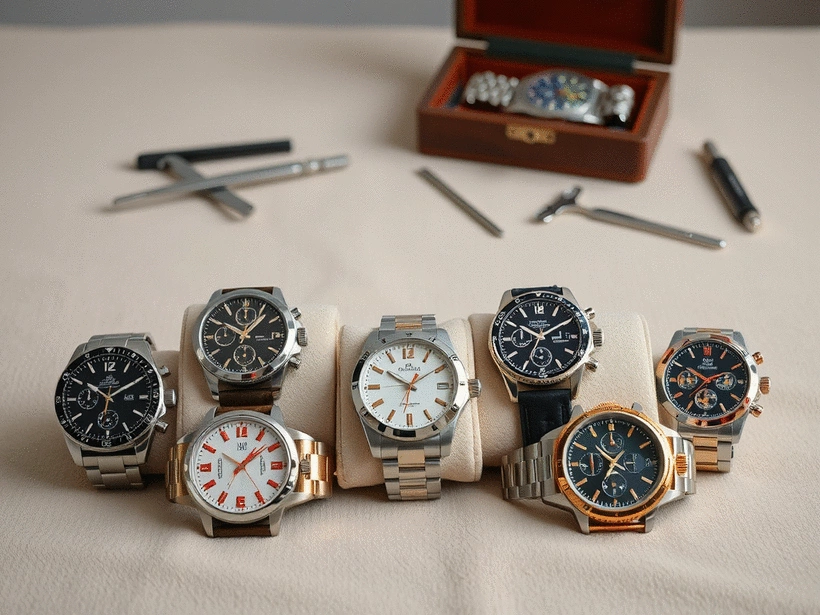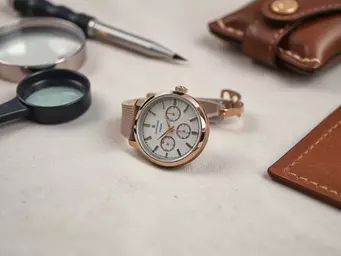Essential Watch Terms for Beginners

As you embark on your journey into the intricate world of wristwatches, understanding the terminology can be your greatest ally. This knowledge not only enhances your appreciation for the craftsmanship behind each piece but also allows you to make informed choices that reflect your unique style. So, are you ready to transform your watch shopping experience?
What You Will Learn
- How mastering watch terminology enhances your appreciation and helps you make informed decisions.
- Key watch terms every beginner should know, such as 'movement', 'case', and 'dial'.
- Common challenges faced by new watch enthusiasts and how to overcome them.
- Practical tips for improving your understanding of watch terminology through various resources.
- The impact of different watch straps and bracelets on the overall style and wearability of a watch.
Bridging the Gap: Understanding Watch Terminology for Beginners
Navigating the world of horology can be daunting for newcomers. This visual breaks down the core challenges and essential terms, highlighting how understanding watch terminology enhances appreciation and empowers enthusiasts.
Why it Matters Importance of Watch Terminology
- ✓ Enhanced Appreciation
- ✓ Informed Decisions
- ✓ Boosted Confidence
Beginner's Hurdles Common Challenges
- ✗ Technical Jargon
- ✗ Brand-Specific Language
- ✗ Varied/Misunderstood Features
Essential Vocabulary Important Terms for Beginners
- ● Case
- ● Movement
- ● Dial
- ● Crown
- ● Bezel
Mastering Horology Improve Your Understanding
- ✓ Read Books/Articles
- ✓ Join Online Forums
- ✓ Watch Tutorials
- ✓ Attend Workshops
Style & Function Different Watch Straps
- ● Leather Straps
- ● Metal Bracelets
- ● NATO Straps
- ● Rubber Straps
Understanding Watch Terminology: Why It Matters for Beginners
When diving into the world of wristwatches, having a solid understanding of watch terminology can truly enhance your buying experience! Knowing the right terms not only helps you appreciate the intricate details of a watch but also enables you to make informed decisions that reflect your individual style. At Wrist Watches for Men, we believe that every man should feel confident in selecting a timepiece that embodies his personality.
Moreover, familiarizing yourself with watch terms can elevate your conversations with fellow enthusiasts. Imagine being able to discuss the nuances of a caliber or the significance of a watch's mechanism! This vocabulary allows for a deeper connection with the craftsmanship that goes into each timepiece.
Recognizing the Importance of Watch Terms
Understanding watch terminology is essential for beginners, as it shapes your overall experience with horology. Many first-time buyers may feel overwhelmed, but taking the time to learn these terms can transform your journey from daunting to exciting!
- Enhanced Appreciation: Knowing what makes a watch unique helps you appreciate its design and craftsmanship.
- Informed Decisions: Familiarity with terms aids in comparing watches effectively.
- Boosted Confidence: Mastering the language of watches allows you to engage in discussions with experts and fellow enthusiasts. For a comprehensive list of terms, you can refer to this watch terminology glossary.
By grasping these concepts, you will feel empowered during your watch shopping adventures. It’s like having a secret tool that unlocks the world of horology!
Common Challenges Faced by New Watch Enthusiasts
When first encountering watch terminology, many newcomers often grapple with confusion over specific terms. For instance, what is the difference between a chronograph and a chronometer? Understanding these distinctions can be difficult but is crucial for all watch enthusiasts. You can find more details on these and other terms in this luxury watch glossary.
- Technical Jargon: Newcomers may feel lost with terms like movement, complication, and bezel.
- Brand-Specific Language: Different brands often use unique terminology that can add to the confusion.
- Varied Features: Features like water resistance and power reserve are often misunderstood.
Don’t worry—everyone starts somewhere! By familiarizing yourself with these challenges and seeking guidance, you can navigate the world of watches with ease. Remember, each term learned is a step closer to becoming a confident watch enthusiast!
Engage with Your Watch Journey!
As you dive deeper into the world of watches, we want to know: What aspect of watch terminology excites you the most? Is it the intricate mechanics, the stylish designs, or perhaps the history behind renowned brands? Share your thoughts below:
Addressing Common Questions About Watch Terminology
What Are the Most Important Watch Terms for Beginners?
As you embark on your watch journey, it’s essential to familiarize yourself with some fundamental watch terms. Understanding these key concepts will not only enhance your appreciation of wristwatches but also empower you to make informed choices. Here are some important terms every beginner should prioritize learning:
- Case: The protective housing that holds the watch's movement and dial.
- Movement: The mechanism that powers the watch—either quartz or mechanical.
- Dial: The face of the watch where time is displayed, often featuring markers and hands.
- Crown: The knob used to set the time and date, often used for winding mechanical watches.
- Bezel: The ring surrounding the dial, which can be functional or purely aesthetic.
These terms form the backbone of your watch vocabulary, helping you navigate the exciting world of horology with confidence! I remember the thrill of learning these basics and how they opened my eyes to the intricacies of timepieces.
How Can I Improve My Understanding of Watch Terminology?
Improving your grasp of watch terminology can be a fun and rewarding process. Here are some practical tips to enhance your learning:
- Read Books and Articles: Explore literature on watchmaking and horology to expand your vocabulary.
- Join Online Forums: Engage with communities like those on Wrist Watches for Men, where enthusiasts share insights and experiences.
- Watch Tutorials: Look for video content that explains terminology in a visual and engaging way.
- Attend Workshops: If possible, participate in local watch-related events or workshops to learn from experts. For more beginner-friendly terminology, check out this guide on essential watch terminology.
By actively engaging with these resources, your understanding of watch terminology will deepen, helping you appreciate each timepiece's artistry and function. It's like discovering a new language that opens up a world of craftsmanship!
What Should I Know About Different Watch Straps and Bracelets?
The type of strap or bracelet your watch features significantly impacts its overall style and wearability. Here are the most common types you should know about:
- Leather Straps: Offer a classic look, comfortable feel, and can range from casual to formal.
- Metal Bracelets: Typically made of stainless steel or titanium, they provide durability and a sophisticated appearance.
- NATO Straps: Made from nylon, these are versatile and great for casual wear or outdoor activities.
- Rubber Straps: Ideal for sports and diving watches, they are both comfortable and water-resistant.
Each of these options brings its unique flair to a watch and can dramatically change its character. I’ve seen how a simple strap switch can breathe new life into a timepiece, making it feel fresh and exciting!
Next Steps in Your Watch Journey
How to Choose Your First Watch with Confidence
As you prepare to select your first watch, use the terminology you've learned to make informed decisions. Consider factors like movement type, case size, and strap material to ensure your choice aligns with your personal style and needs. It’s all about finding a timepiece that feels like it was made just for you! Remember, your first watch isn't just a tool; it's an extension of your personality.
Continuing Your Education in Watch Collecting
To further your education in watch collecting, immerse yourself in various resources. Explore blogs, podcasts, and YouTube channels dedicated to horology. Joining communities, such as those surrounding Wrist Watches for Men, can also provide invaluable insights and networking opportunities. The world of watches is vast and ever-evolving, so there’s always something new to learn!
Frequently Asked Questions About Watch Terminology
- Q: Why is understanding watch terminology important for beginners?
- A: Understanding watch terminology enhances your appreciation for watch craftsmanship, helps you make informed purchasing decisions, boosts your confidence in discussing watches, and allows for a deeper connection with the horology community.
- Q: What are the common challenges new watch enthusiasts face?
- A: New enthusiasts often struggle with technical jargon (e.g., movement, complication), brand-specific language, and misunderstanding varied features like water resistance and power reserve.
- Q: What are some essential watch terms every beginner should know?
- A: Key terms include 'case' (the watch's housing), 'movement' (the mechanism powering it), 'dial' (the face), 'crown' (for setting time/date), and 'bezel' (the ring around the dial).
- Q: How can I improve my knowledge of watch terminology?
- A: You can improve your understanding by reading books and articles, joining online forums, watching tutorials, and attending watch-related workshops.
- Q: What are the main types of watch straps and their impact on style?
- A: Common strap types include leather (classic, versatile), metal bracelets (durable, sophisticated), NATO straps (casual, versatile), and rubber straps (sporty, water-resistant). Each significantly affects the watch's overall style and wearability.
Recap of Key Points
Here is a quick recap of the important points discussed in the article:
- Understanding Watch Terminology: Familiarizing yourself with essential terms enhances appreciation and informed decision-making when selecting a watch.
- Common Challenges: New enthusiasts may struggle with technical jargon and brand-specific language, but learning can simplify the experience.
- Key Terms for Beginners: Important terms include case, movement, dial, crown, and bezel, forming the foundation of watch vocabulary.
- Improving Knowledge: Reading, engaging in forums, watching tutorials, and attending workshops are effective ways to deepen understanding.
- Types of Straps: The choice of strap—be it leather, metal, NATO, or rubber—significantly affects the watch's style and function.
- Choosing Your First Watch: Use learned terminology to select a timepiece that reflects your style and needs confidently.
